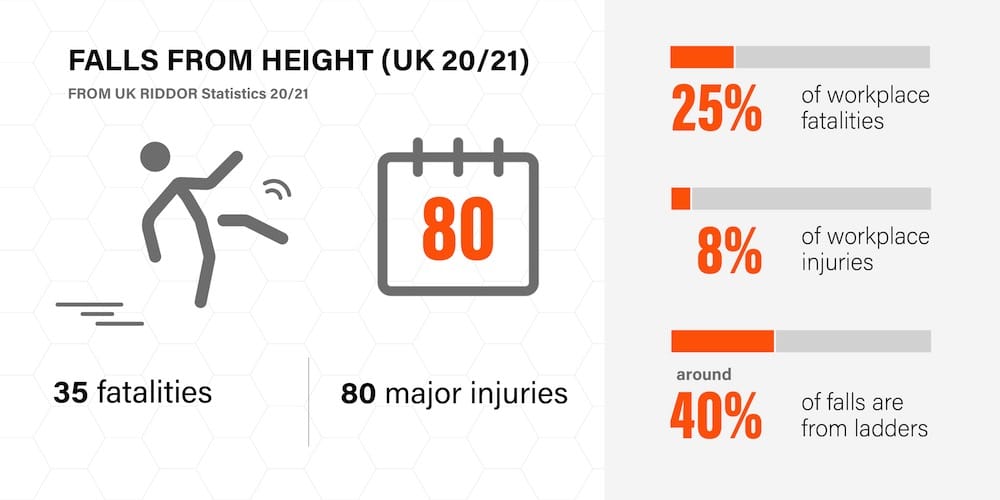According to the newest HSE report on occupational accidents in the UK, fatal injuries from falls from a height remained the most common cause of death to workers across reporting year from 2021/2022. This data is gathered from RIDDOR statistics.
Falls from a height accounted for 29 of a total of 123 UK workplace fatalities across the year. This is down from 35 fatalities the previous year. As you may imaging most of these fatalities occurred in the construction sector.

The natural conclusion would be to expect that working at heights to be a dangerous undertaking.
However, falls from a height are a rather uncommon type of workplace accident.
Only 7% of all non-fatal injuries between 2014 and 2017 were related to falls from height, whilst injuries from handling, lifting or carrying objects made up 20% of workplace accidents.
In other words, falls from a height don’t happen as frequently as other types of accidents but when they do, they are far more likely to be fatal.
This is not surprising, considering how falls from a height commonly cause injuries to the spinal, head, or neck, and vital organs. A fall from 10 meters or above is most probably lethal but even 2 meters can prove dangerous when falling on the wrong surface or body part. The high fatality-rate of falls from height is simply to do with the high likelihood of causing a fatal injury.
The value of fall protection
As with any kind of worksite or working environment, it is important to identify potential sources of danger before work starts. In the construction industry, that means analysing the risk of accidents, in particular, ranging from machinery-related hazards to dangerous objects, substances, trips, slips, and – very importantly – falls.
Whilst the danger from falling off a roof or scaffold, for example, should be obvious to anyone, common sense seems to elude many employers and employees alike when working at height. Often, workers seem to believe that fall protection is not necessary when only exposed for a brief time, or that they will simply hold on firmly so that safety equipment becomes redundant. Hard to believe from an outsider perspective, but, unfortunately, quite a common scenario on site.
In fact, laziness and overestimating one’s own capabilities are reasons for many types of accidents across many industries but when working at heights, they become a fatal mistake that won’t be repeated.
Unfortunately, it is not as easy as telling managers to make sure employers are complying with safety requirements. What is written as a regulation on paper and what safety behaviour is found in reality can differ drastically. Instead, the goal should be to establish a healthy safety culture in the workplace that communicates the necessity of safety to the employee, so compliance becomes a voluntary, and natural behaviour.
Communicating necessity
Employees tend to only put effort when they feel they can gain something from it. Therefore, safety needs to be communicated as a valuable procedure to make workers want tofollow regulations. Managers should not trust that telling their employees to use safety gear will make them do so – instead, they need to educate them on why they would want touse safety gear.
An experienced health and safety consultant will be able to create a sense of urgency within the team to encourage them to show more interest in safety, but it is also a matter of equipping staff with the knowledge and training needed to use gear correctly. Fall protection is partly equipment – but also expertise in how to spot hazards, choosing the right protection, and using it in a way that safety can actually be guaranteed.
For the employer, safety training and assessments can sometimes feel like a waste of time and money as they interrupt the usual work day. However, safety training should not just be thought of as a “fun team-building exercise”. In fact, they can create far more value to a company than visible at first glance.
Investing in injury prevention can return multiple times the cost of compliance as workers’ productivity increases, contentment with work and workplace validation become greater, and fewer workplace interruptions overall create sustainable business value. The truth is, that safety is not only valuable on a humanitarian level but also financially.
Changing the status quo
To make safety compliance a priority is to emphasise on sustainability, longevity, and trust. The construction industry is dearly in need of a safety culture that focuses on teaching workers how to safeguard themselves from dangerous situations, rather than prioritising quick and cheap work.
Working at heights does come with its own unique hazards that pose a greater threat to the worker than working on the level ground. Instead of accepting the hazardous nature of working at heights, employers need to start thinking about how to lower the high fatality-rate in their job regardless of its nature.
End of the articles detailing Why Falls from Height Remain a Source of Fatal Accident








